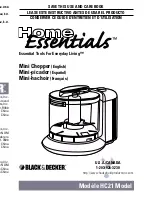
OPTIMOD-TV DIGITAL
INTRODUCTION
1-11
Studio-Transmitter Link
Transmission from Studio to Transmitter
There are several types of studio-transmitter links (STLs) in common use in broadcast
service: uncompressed digital, digital with lossy compression (like MPEG, Dolby
®
, or
APT-x
®
), microwave, analog landline (telephone / post line), and audio subcarrier on
a video microwave STL.
STLs are used in three fundamentally different ways. They can either:
pass unprocessed audio for application to the 8382’s input, or
pass the 8382’s peak-controlled analog or digital left and right audio outputs, or
pass the composite stereo baseband output of an external stereo encoder
driven by OPTIMOD-TV’s analog or AES3 output.
The three applications have different performance requirements. In general, a link
that passes unprocessed audio should have very low noise and low non-linear distor-
tion, but its transient response is not important. A link that passes processed audio
does not need as low a noise floor as a link passing unprocessed audio. However, its
transient response is critical. At the current state of the art, an uncompressed digital
link using digital inputs and outputs to pass audio in left/right format achieves best
results. We will elaborate below.
Digital Links
Digital links may pass audio as straightforward PCM encoding, or they may apply
lossy data reduction processing to the signal to reduce the number of bits per sec-
ond required for transmission through the digital link. Such processing will almost
invariably distort peak levels, so such links must therefore be carefully qualified be-
fore you use them to carry the peak-controlled output of the 8382 to the transmit-
ter. For example, the MPEG Layer 2 algorithm can increase peak levels up to 4 dB at
160 kB/sec by adding large amounts of quantization noise to the signal. While the
desired program material may psychoacoustically mask this noise, it is nevertheless
large enough to affect peak levels severely. For any lossy compression system the
higher the data rate, the less the peak levels will be corrupted by added noise, so
use the highest data rate practical in your system.
It is practical (though not ideal) to use lossy data reduction to pass unprocessed au-
dio to the 8382’s input. The data rate should be at least of “contribution quality”—
the higher, the better. If any part of the studio chain is analog, we recommend using
at least 20-bit A/D conversion before encoding.
Because the 8382 uses multiband limiting, it can dynamically change the frequency
response of the channel. This can violate the psychoacoustic masking assumptions
made in designing the lossy data reduction algorithm. Therefore, you need to leave
“headroom” in the algorithm so that the 8382’s multiband processing will not un-
Summary of Contents for Optimod-TV 8382
Page 22: ......
Page 108: ......
Page 162: ......
Page 174: ......
Page 213: ...OPTIMOD TV DIGITAL TECHNICAL DATA 6 25...
Page 219: ...OPTIMOD TV DIGITAL TECHNICAL DATA 6 31 CPU Module...
Page 225: ...OPTIMOD TV DIGITAL TECHNICAL DATA 6 37 RS232 BOARD PARTS LOCATOR...
Page 227: ...OPTIMOD TV DIGITAL TECHNICAL DATA 6 39 POWER SUPPLY PARTS LOCATOR...
Page 229: ...OPTIMOD TV DIGITAL TECHNICAL DATA 6 41 8382 I O Board Parts Locator...
Page 234: ...6 46 TECHNICAL DATA ORBAN MODEL 8382 DSP BOARD PARTS LOCATOR DRAWING 32170 000 14...
Page 242: ...6 54 TECHNICAL DATA ORBAN MODEL 8382 DISPLAY BOARD PARTS LOCATOR...
Page 243: ...OPTIMOD TV DIGITAL TECHNICAL DATA 6 55 DISPLAY BOARD...
















































